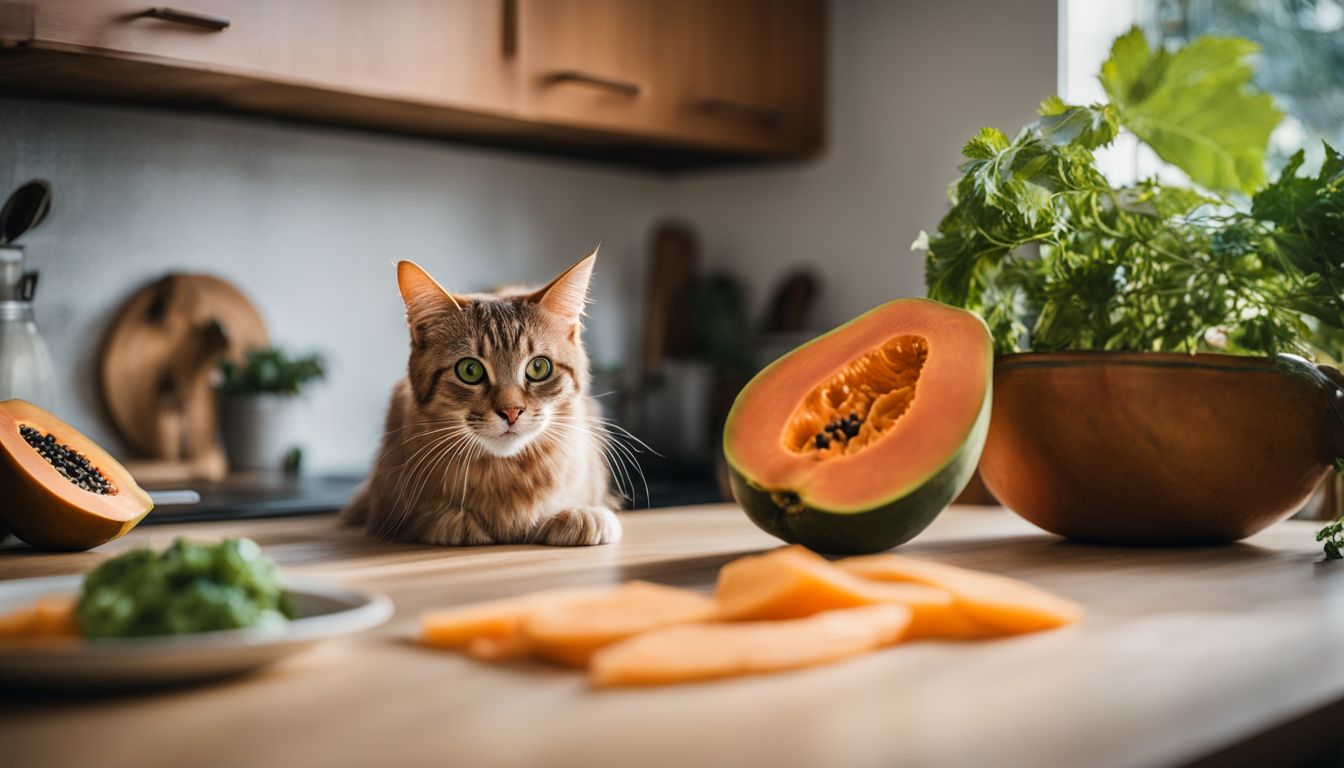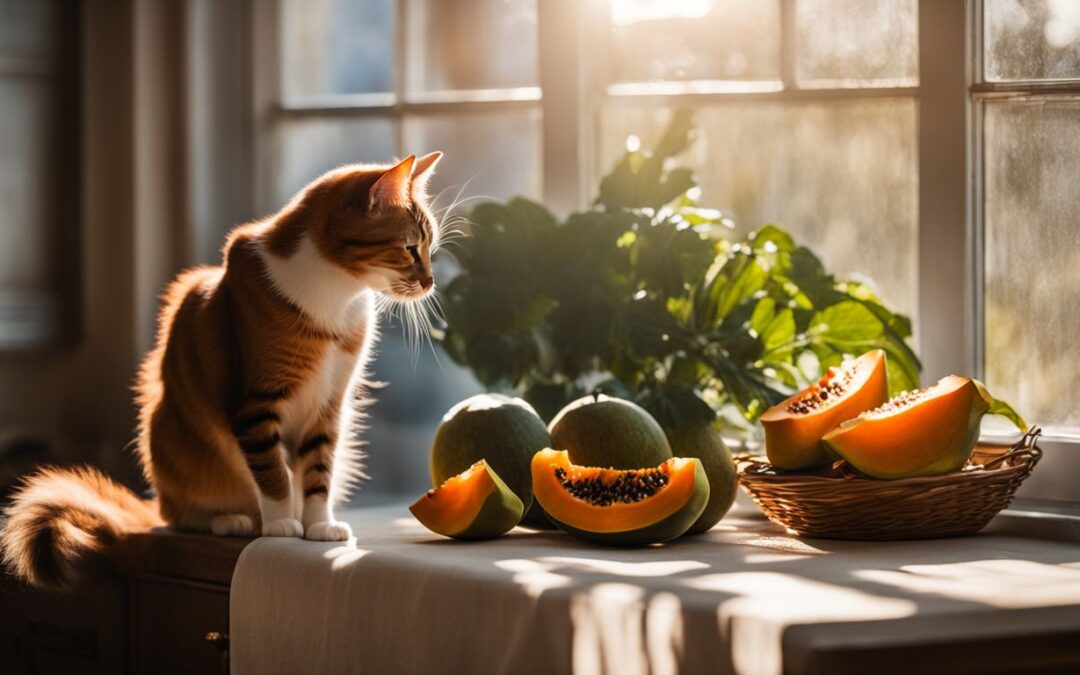Have you ever caught yourself pondering whether your furry companion could indulge in a slice of papaya? You’re not alone! I found myself down that rabbit hole, discovering that although papaya isn’t harmful to our feline pals, it might not be their ticket to a nutritional jackpot.
In this article, we’ll navigate the ins and outs of offering this exotic fruit to your cat. Stay tuned as we ensure your fur baby remains both joyful and thriving!
Key Takeaways
- Cats are meat eaters and papaya is not needed in their diet. Despite its vitamin content, it’s not ideal for them because they can’t use all the nutrients in fruits.
- A tiny bit of papaya won’t hurt your cat but eating a lot can upset their stomach. Always remove seeds to avoid choking risks.
- If you do give your cat papaya, start with a small amount to see how they react. Keep it rare and consult with a vet if you’re unsure.
Understanding Cats’ Dietary Preferences

So, after talking about whether cats can munch on papaya, let’s get into what our feline friends really like to eat. Cats are curious creatures. They love meat. Yes, you heard that right – they need it! This is because they’re obligate carnivores.
What this fancy term means is simple: their bodies are designed to get nutrients from animal flesh.
Their diet needs to be rich in protein from animals. They can’t turn beta-carotene into vitamin A the way we do, which makes fruits and veggies less useful for them. Plus, their tummy isn’t great at breaking down plant fibers either.
So while a small chunk of pawpaw won’t hurt them, it doesn’t help much with their nutritional needs. Always remember – cats thrive best on cat foods that pack a lot of animal proteins and fats rather than sugars or carbs found in human foods like fruits.
Can Cats Eat Papaya?

Cats and Papaya: A Surprising Combination!
Do cats really like papaya? What happens if a cat eats papaya?
The Nutritional Science Behind Cats and Papaya
So, let’s talk about why feeding papaya to your furry friend might not be as helpful as you’d think. Sure, papaya is a powerhouse of vitamin C and has lots of minerals that sound like they’re straight out of a health guru’s handbook.
But here’s the rub: our feline buddies are obligate carnivores. This fancy term means their bodies are made to chow down on meat, not fruits or veggies. They have this superpower where they don’t need to eat foods rich in vitamin C because their bodies can make it all by themselves – pretty cool, huh? Plus, the whole deal with beta-carotene (that thing that turns into vitamin A) doesn’t work for them like it does for us; they just can’t turn it into something useful.
Now, onto this other bit about digesting proteins – cats are pros at breaking down animal proteins (thanks to their unique gut setup), but tossing them a piece of tropical fruit like papaya? Not so much.
Imagine trying to use a hammer on a screw – wrong tool for the job! Papayas do have enzymes that help break down protein outside the body (like when cooking), but inside our cat’s belly? It’s just not going to do much except maybe taste weirdly sweet.
And let me tell you, “sweet” isn’t high on the list of kitty flavor favorites; these guys are more about the savory life. So even though we love loading up on tropical goodness for its health benefits and juicy sweetness, we’ve got to remember our pets’ needs aren’t quite aligned with ours in this case.
Considering Cats’ Reaction to Papaya
Okay, let’s talk about how our furry friends feel about papaya. From what we know, these fuzzy family members usually don’t care much for fruits or veggies. That includes papayas. They walk past it like it’s just another piece of boring furniture.
But if they do try a bit, most won’t have any big problem with it right away.
Now, I’ve noticed that some cats might nibble on papaya if they find its smell interesting or just out of curiosity. But here’s the thing – their bodies aren’t made to handle a lot of fruit sugar or fiber well.
So even though papaya isn’t harmful to them in tiny bits, feeding them too much can lead to an upset stomach. Imagine having to clean up after that mess! Plus, those pesky seeds could be trouble since they’re hard and could cause choking if not removed first.
All in all, while a small bit of this tropical fruit can be okay once in a blue moon—making sure it’s seedless and given as more of an odd treat rather than part of their daily chow is key.
Health Benefits of Papaya for Cats
Papaya can bring some health benefits when cats eat it. Although not a complete nutritional powerhouse for them, it does contain vitamins like vitamin C and E that support their immune system.
It also contains fiber which may aid in digestion for cats struggling with constipation. Moreover, the enzyme papain found in papaya is believed to have anti-inflammatory properties and could assist in soothing digestive discomfort.
Additionally, the presence of antioxidants in papayas has been linked to various health benefits such as promoting heart health and reducing the risk of chronic diseases. However, moderation is key as large portions might lead to digestive issues like diarrhea due to its high sugar content.
Therefore, while it’s fine for cats to enjoy small amounts of papaya occasionally, it’s important not to overdo it due to potential negative effects on their digestive system.
Quantities of Papaya Ideal for Cats
Feeding your cat papaya can be beneficial in small amounts. It’s best to offer a tiny serving, like a few small cubes or a teaspoon of mashed papaya, and observe how your cat reacts.
Keep an eye out for any signs of digestive upset, and monitor their overall well-being when introducing new foods. Remember to consult with your veterinarian before making any significant changes to your cat’s diet.
Papaya is suitable in moderation because it contains fiber and nutrients that can complement a cat’s diet. However, overfeeding could lead to stomach discomfort due to its high fiber content.
It’s important not only to consider the ideal quantity but also the frequency of feeding papaya as part of your feline friend’s diet plan.
The Risks and Precautions of Feeding Cats Papaya
When considering feeding cats papaya, it’s essential to be cautious about potential hazards and take necessary precautions. Ensuring that the papaya is ripe and free from seeds will help prevent any digestive issues or choking hazards for your feline friend.
Feeding Dried Papaya to Cats
Feeding dried papaya to cats might seem like a treat, but it’s best to steer clear. Dried papaya packs a sugary punch that’s more akin to candy than fruit. This high sugar content isn’t suitable for our feline friends and can lead to obesity and other health issues.
Instead, opt for dried meat as an occasional snack for your cat. It is lower in sugar and much healthier for them.
When considering the treats we give our pets, it’s important to focus on their well-being over what may seem appealing or convenient at the moment. So when reaching for a snack, remember: skip the dried papaya and choose healthier options!
Potential Hazards of Papaya Seeds for Cats
Papaya seeds don’t offer much to cats nutritionally and could cause choking. Avoid giving your cat papaya seeds as they can get stuck in their throat.
Feeding cats or any other animals with fruit seeds may cause choking, so be sure to keep these away from your feline friend.
How to Safely Introduce Papaya to Your Cat’s Diet
When introducing papaya to your cat’s diet, it’s important to do it gradually. Start by offering a small amount, about a teaspoon, and observe their reaction. If they show any signs of digestive upset or allergic reactions, such as vomiting or diarrhea, discontinue feeding them papaya and consult your veterinarian.
- Begin by Offering Small Portions: When introducing papaya to your cat’s diet, start with very small portions – around a teaspoon should suffice for the initial trial.
- Observe Their Reaction: Keep an eye on how your cat responds to the papaya. Look out for any signs of discomfort or adverse reactions after consuming the fruit.
- Gradually Increase Quantity: If your cat tolerates the small portion well, you can gradually increase the quantity over time. Monitor their response at each stage to ensure they’re comfortable with the new addition to their diet.
- Avoid Feeding Unripe Papaya: Make sure that the papaya is ripe when given to your cat. Unripe papaya may cause digestive issues and should be avoided.
- Consider Mixing with Regular Food: To make the introduction smoother for your cat, consider mixing small amounts of mashed ripe papaya with their regular food.
- Consult Your Veterinarian: If you have any concerns about adding papaya to your cat’s diet or if your cat shows any negative responses, it’s best to seek advice from your veterinarian.
By following these steps and monitoring your cat’s reaction closely, you can safely introduce papaya into their diet if it suits them well without causing any issues.
Conclusion
Cats can eat papaya, but it doesn’t provide much nutrition for them. Fruits are not a necessary part of their diet. Eating too much papaya may cause digestive issues for cats. While it’s safe to give them a small piece, it’s best to avoid feeding them papaya regularly.
Overall, cats don’t need fruits like papaya in their diet. It’s better to stick to proteins and fats for their meals.
If you’re curious about other safe treats for your feline friend, discover whether cats can eat canned salmon.
FAQs
1. “Can my cat really munch on papaya?”
Sure thing! Unlike their feelings about Monday mornings, cats might actually enjoy the sweet taste of papaya. It’s full of nutritional value and doesn’t come with the scary stuff like cyanide poisoning – looking at you, apples!
2. “But wait… what about all that sugar in fruits? Is it safe?”
Ah, yes – the sugar question. While papayas do have fructose (that’s fruit sugar), they’re not as loaded as, say, a bottle of ketchup or a slice of cake. Moderation is key here; think of it as a tiny treat rather than a main dish.
3. “Are there any no-no foods I should avoid giving my kitty?”
Oh boy, where do I start? Avocados and citrus fruits are big no-nos due to their toxic components for cats – sorry guacamole fans! Also steer clear from anything with caffeine or alcohol (but you knew that already), and tomatoes can be tricky too.
4. “What should I do if my furry friend has a sensitive tummy?”
Cats with irritable bowel syndrome need extra care when it comes to diet changes. Introducing new foods like papaya slowly is wise to avoid any upset stomachs – nobody wants an emergency trip to the animal hospital!
5. “Is there such thing as too much of a good thing when feeding papaya to cats?”
Absolutely! Just like humans can overdo it on vitamins (hello, neon pee!), kitties can get too much Vitamin C from fruits like kiwis or blackberries…and yes, even our beloved papayas.
6. “Any tips for serving up this tropical treat?”
Get creative but keep it simple: dice up some fresh papaya into small bite-sized pieces – forget about dried fruit or juice versions since they pack more sugar punch per bite – and maybe serve it in their favorite bowl (Hepper NomNom Cat Bowl anyone?) for an added touch.






